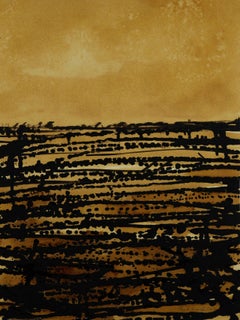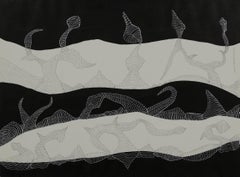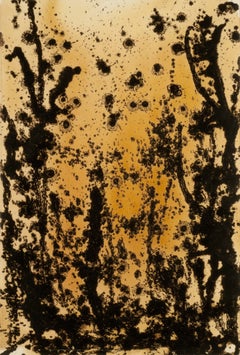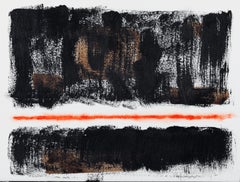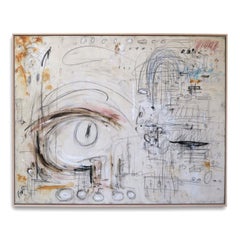Ray H. French Abstract Drawings and Watercolors
to
3
1
1
2
Overall Height
to
Overall Width
to
2
3
3
27
136
124
78
70
2
1
1
Artist: Ray H. French
Untitled
By Ray H. French
Located in Fairlawn, OH
Signed and dated "1962" by the artist lower right.
Mixed media on heavy paper.
Done for a show to fund a trip to Italy.
Category
1960s Abstract Ray H. French Abstract Drawings and Watercolors
Materials
Ink, Mixed Media
Sea Forms
By Ray H. French
Located in Fairlawn, OH
Signed and dated center right edge; Annotated "48" lower left
Provenance:
Estate of the artist
One of a suite of 120 drawings that the artist did in 1 month.
Most were sold thro...
Category
1960s Abstract Ray H. French Abstract Drawings and Watercolors
Materials
Ink, Pen
Untitled (Abstraction)
By Ray H. French
Located in Fairlawn, OH
Signed and dated by the artist vertically lower left edge.
Part of an experimental series of works using motor oil, India Ink, adhesives, sand, and various other mediums.
Category
1960s Ray H. French Abstract Drawings and Watercolors
Related Items
Thread
By Ed Touchette
Located in Gloucester, MA
Ed Touchette (b. 1948) is inspired by a love of architecture and public spaces to make paintings which express joyful wonder at our built environment — ol...
Category
2010s Bauhaus Ray H. French Abstract Drawings and Watercolors
Materials
Ink, Acrylic, Watercolor
"Eye of the Beholder" Acrylics, Pencils, Oil Pastels in Neutral Hues of Taupe
By Karina Gentinetta
Located in New York, NY
"Eye of the Beholder" 2024, 48"x60" horizontal abstract painting by Argentine-born artist Karina Gentinetta (featured in Elle Decor, Architectural Digest, the New York Times, Traditi...
Category
21st Century and Contemporary Abstract Expressionist Ray H. French Abstract Drawings and Watercolors
Materials
Oil Pastel, Acrylic, Carbon Pencil, Color Pencil
Karina Gentinetta"Eye of the Beholder" Acrylics, Pencils, Oil Pastels in Neutral Hues of Taupe, 2024
H 49.5 in W 69.5 in D 1.5 in
Abstract Watercolor N.8 by Dmitry Samygin
By Dmitry Samygin
Located in Paris, FR
Abstract Watercolor N.8 by Dmitry Samygin
Minimalist and geometric paintings.
Technique: Watercolor
Color: Teal blue
Size: H. 35.5 x 27.5 x 0.1 cm
Dmitry Samygin is a Furniture a...
Category
21st Century and Contemporary Abstract Geometric Ray H. French Abstract Drawings and Watercolors
Materials
Watercolor
F.L.A.A.T.T.
By Sophie Roach
Located in Philadelphia, PA
Original 30in x 20in drawing on paper mounted to wood panel by Austin-based Texas artist Sophie Roach.
Sophie Roach is a self-taught artist and illustrator based in Austin, TX. She discovered her passion for compulsive drawing when she was supposed to be paying attention to lectures at the University of Washington. By using familiar shapes, patterns and her own intuition, Roach has created a unique visual language based on spontaneity and rhythm. Her abstract style is playful yet austere, extremely detailed and often vibrantly colored.
Her client list includes, among others, Nike, Converse, Complex, Fiat, IBM, Kit & Ace, Austin City Limits...
Category
21st Century and Contemporary Abstract Ray H. French Abstract Drawings and Watercolors
Materials
Archival Ink, Archival Paper, Pen, Wood Panel
"Untitled" Acrylics, Pencils, Oil Pastels on Paper in Neutral Hues of Taupe
By Karina Gentinetta
Located in New York, NY
"Untitled" 2019, 25" x 31" horizontal drawing on paper by Argentine-born artist Karina Gentinetta (featured in Elle Decor, the New York Times, Tradi...
Category
21st Century and Contemporary Abstract Expressionist Ray H. French Abstract Drawings and Watercolors
Materials
Glaze, Oil Pastel, Acrylic, Carbon Pencil
Contemporary Watercolor Painting, 'Design for Space', 2022 by David Ruth
By David Ruth
Located in Oakland, CA
This is a contemporary abstract watercolor painting by artist David Ruth. This series of paintings often feature bright colors and vibrant layouts that draw the viewer in. They are c...
Category
2010s Abstract Expressionist Ray H. French Abstract Drawings and Watercolors
Materials
Paper, Watercolor
1950s Abstract Composition in Brown, Orange and Blue with Black Parallel Lines
By Herbert Bayer
Located in Denver, CO
Watercolor and ink on paper of an abstract composition of brown, orange and blue shapes between black parallel lines throughout the the piece by Herbert Bayer (1900-1985). Presented in a custom black frame with all archival materials. Framed dimensions measure 17 ⅞ x 22 ⅝ x 1 inches. Image size is 10 ¼ x 15 ½ inches.
Painting is clean and in very good condition - please contact us for a detailed condition report.
Expedited and international shipping is available - please contact us for a quote.
About the Artist:
Herbert Bayer enjoyed a versatile sixty-year career spanning Europe and America that included abstract and surrealist painting, sculpture, environmental art, industrial design, architecture, murals, graphic design, lithography, photography and tapestry. He was one of the few “total artists” of the twentieth century, producing works that “expressed the needs of an industrial age as well as mirroring the advanced tendencies of the avant-garde.”
One of four children of a tax revenue officer growing up in a village in the Austrian Salzkammergut Lake region, Bayer developed a love of nature and a life-long attachment to the mountains. A devotee of the Vienna Secession and the Vienna Workshops (Wiener Werkstätte) whose style influenced Bauhaus craftsmen in the 1920s, his dream of studying at the Academy of Art in Vienna was dashed at age seventeen by his father’s premature death.
In 1919 Bayer began an apprenticeship with architect and designer, Georg Schmidthamer, where he produced his first typographic works. Later that same year he moved to Darmstadt, Germany, to work at the Mathildenhöhe Artists’ Colony with architect Emanuel Josef Margold of the Viennese School. As his working apprentice, Bayer first learned about the design of packages – something entirely new at the time – as well as the design of interiors and graphics of a decorative expressionist style, all of which later figured in his professional career.
While at Darmstadt, he came across Wassily Kandinsky’s book, Concerning the Spiritual in Art, and learned of the new art school, the Weimar Bauhaus, in which he enrolled in 1921. He initially attended Johannes Itten’s preliminary course, followed by Wassily Kandinsky’s workshop on mural painting. Bayer later recalled, “The early years at the Bauhaus in Weimar became the formative experience of my subsequent work.” Following graduation in 1925, he was appointed head of the newly-created workshop for print and advertising at the Dessau Bauhaus that also produced the school’s own print works. During this time he designed the “Universal” typeface emphasizing legibility by removing the ornaments from letterforms (serifs).
Three years later he left the Bauhaus to focus more on his own artwork, moving to Berlin where he worked as a graphic designer in advertising and as an artistic director of the Dorland Studio advertising agency. (Forty years later he designed a vast traveling exhibition, catalog and poster -- 50 Jahre Bauhaus -- shown in Germany, South America, Japan, Canada and the United States.) In pre-World War II Berlin he also pursued the design of exhibitions, painting, photography and photomontage, and was art director of Vogue magazine in Paris. On account of his previous association with the Bauhaus, the German Nazis removed his paintings from German museums and included him among the artists in a large exhibition entitled Degenerate Art (Entartete Kunst) that toured German and Austrian museums in 1937.
His inclusion in that exhibition and the worsening political conditions in Nazi Germany prompted him to travel to New York that year with Marcel Breuer, meeting with former Bauhaus colleagues, Walter Gropius and László Moholy-Nagy to explore the possibilities of employment after immigration to the United States. In 1938 Bayer permanently relocated to the United States, settling in New York where he had a long and distinguished career in practically every aspect of the graphic arts, working for drug companies, magazines, department stores, and industrial corporations. In 1938 he arranged the exhibition, “Bauhaus 1919-1928” at the Museum of Modern Art, followed later by “Road to Victory” (1942, directed by Edward Steichen), “Airways to Peace” (1943) and “Art in Progress” (1944).
Bayer’s designs for “Modern Art in Advertising” (1945), an exhibition of the Container Corporation of America (CAA) at the Art Institute of Chicago, earned him the support and friendship of Walter Paepcke, the corporation’s president and chairman of the board. Paepcke, whose embrace of modern currents and design changed the look of American advertising and industry, hired him to move to Aspen, Colorado, in 1946 as a design consultant transforming the moribund mountain town into a ski resort and a cultural center. Over the next twenty-eight years he became an influential catalyst in the community as a painter, graphic designer, architect and landscape designer, also serving as a design consultant for the Aspen Cultural Center.
In the summer of 1949 Bayer promoted through poster design and other design work Paepcke’s Goethe Bicentennial Convocation attended by 2,000 visitors to Aspen and highlighted by the participation of Albert Schweitzer, Arthur Rubenstein, Jose Ortega y Gasset and Thornton Wilder. The celebration, held in a tent designed by Finnish architect Eero Saarinen, led to the establishment that same year of the world-famous Aspen Music Festival and School regarded as one of the top classical music venues in the United States, and the Aspen Institute for Humanistic Studies in (now the Aspen Institute), promoting in Paepcke’s words “the cross fertilization of men’s minds.”
In 1946 Bayer completed his first architecture design project in Aspen, the Sundeck Ski Restaurant, at an elevation of 11,300 feet on Ajax Mountain. Three years later he built his first studio on Red Mountain, followed by a home which he sold in 1953 to Robert O. Anderson, founder of the Atlantic Richfield Company who became very active in the Aspen Institute. Bayer later designed Anderson’s terrace home in Aspen (1962) and a private chapel for the Anderson family in Valley Hondo, New Mexico (1963).
Transplanting German Bauhaus design to the Colorado Rockies, Bayer created along with associate architect, Fredric Benedict, a series of buildings for the modern Aspen Institute complex: Koch Seminar Building (1952), Aspen Meadows guest chalets and Center Building (both 1954), Health Center and Aspen Meadows Restaurant (Copper Kettle, both 1955). For the grounds of the Aspen Institute in 1955 Bayer executed the Marble Garden and conceived the Grass Mound, the first recorded “earthwork” environment In 1973-74 he completed Anderson Park for the Institute, a continuation of his fascination with environmental earth art.
In 1961 he designed the Walter Paepcke Auditorium and Memorial Building, completing three years later his most ambitious and original design project – the Musical Festival Tent for the Music Associates of Aspen. (In 2000 the tent was replaced with a design by Harry Teague.) One of Bayer’s ambitious plans from the 1950s, unrealized due to Paepcke’s death in 1960, was an architectural village on the outskirts of the Aspen Institute, featuring seventeen of the world’s most notable architects – Walter Gropius, Marcel Breuer, I.M. Pei, Minoru Yamasaki, Edward Durrell Stone and Phillip Johnson – who accepted his offer to design and build houses.
Concurrent with Bayer’s design and consultant work while based in Aspen for almost thirty years, he continued painting, printmaking, and mural work. Shortly after relocating to Colorado, he further developed his “Mountains and Convolutions” series begun in Vermont in 1944, exploring nature’s fury and repose. Seeing mountains as “simplified forms reduced to sculptural surface in motion,” he executed in 1948 a series of seven two-color lithographs (edition of 90) for the Colorado Springs Fine Arts Center. Colorado’s multi-planal typography similarly inspired Verdure, a large mural commissioned by Walter Gropius for the Harkness Commons Building at Harvard University (1950), and a large exterior sgraffito mural for the Koch Seminar Building at the Aspen Institute (1953).
Having exhausted by that time the subject matter of “Mountains and Convulsions,” Bayer returned to geometric abstractions which he pursued over the next three decades. In 1954 he started the “Linear Structure” series containing a richly-colored balance format with bands of sticks of continuously modulated colors. That same year he did a small group of paintings, “Forces of Time,” expressionist abstractions exploring the temporal dimension of nature’s seasonal molting. He also debuted a “Moon and Structure” series in which constructed, architectural form served as the underpinning for the elaboration of color variations and transformations.
Geometric abstraction likewise appeared his free-standing metal sculpture, Kaleidoscreen (1957), a large experimental project for ALCOA (Aluminum Corporation of America) installed as an outdoor space divider on the Aspen Meadows in the Aspen Institute complex. Composed of seven prefabricated, multi-colored and textured panels, they could be turned ninety degrees to intersect and form a continuous plane in which the panels recomposed like pieces of a jigsaw puzzle. He similarly used prefabricated elements for Articulated Wall, a very tall free-standing sculpture commissioned for the Olympic Games in Mexico...
Category
1950s Abstract Geometric Ray H. French Abstract Drawings and Watercolors
Materials
Paper, Ink, Mixed Media, Watercolor
H 17.75 in W 22.5 in D 1 in
Entity (10) by RJ Raizk, REP by Tuleste Factory
By RJ Raizk
Located in New York, NY
RJ's process consists of applications in the form of repetitive and free flowing strokes to create works that are complex structurally but rhythmic visually. Much can be interpreted ...
Category
21st Century and Contemporary Abstract Ray H. French Abstract Drawings and Watercolors
Materials
Archival Ink, Mixed Media, Watercolor, Archival Paper
Flower #4 (Abstracted Gestural Botanical Still Life in Gray and Violet)
By Anne Francey
Located in Hudson, NY
mixed media on paper, unframed
44 x 30 inches unframed
This is one is a series of modern abstract flower line drawings. With simple forms and a...
Category
1980s Abstract Ray H. French Abstract Drawings and Watercolors
Materials
Archival Ink, Archival Paper, Mixed Media, Paper
Black Holes & Voids
Located in New York, NY
Shanthi Chandrasekar has been trained in the traditional art forms of Kolam and Tanjore-style painting. While many of her works are influenced by her Indian heritage, her true inspir...
Category
2010s Abstract Ray H. French Abstract Drawings and Watercolors
Materials
Resin, Paper, Ink, Pen
Sara Eichner, 16 Layers, 2016, Ink, Rag Paper, Pen
By Sara Eichner
Located in Darien, CT
Sara Eichner wants to create a space where point of view cannot be fixed. Optical games stand in for her struggle to comprehend the complexities of seeing. Using simple drawing tools...
Category
2010s Abstract Geometric Ray H. French Abstract Drawings and Watercolors
Materials
Ink, Rag Paper, Pen
Rave Sister X
Located in London, GB
Rave Sister X, a vibrant watercolour painting on gessoed paper created in 2020, captures the essence of a dance trance in a mesmerizing and abstract manner. This monochromatic artwor...
Category
2010s Contemporary Ray H. French Abstract Drawings and Watercolors
Materials
Watercolor, Gesso, Paper, Acrylic
Ray H. French abstract drawings and watercolors for sale on 1stDibs.
Find a wide variety of authentic Ray H. French abstract drawings and watercolors available for sale on 1stDibs. You can also browse by medium to find art by Ray H. French in ink, mixed media, pen and more. Much of the original work by this artist or collective was created during the 1960s and is mostly associated with the abstract style. Not every interior allows for large Ray H. French abstract drawings and watercolors, so small editions measuring 15 inches across are available. Customers who are interested in this artist might also find the work of Perry Burns, Thomas Hammer, and Jenny Kemp. Ray H. French abstract drawings and watercolors prices can differ depending upon medium, time period and other attributes. On 1stDibs, the price for these items starts at $2,750 and tops out at $4,000, while the average work can sell for $3,500.
